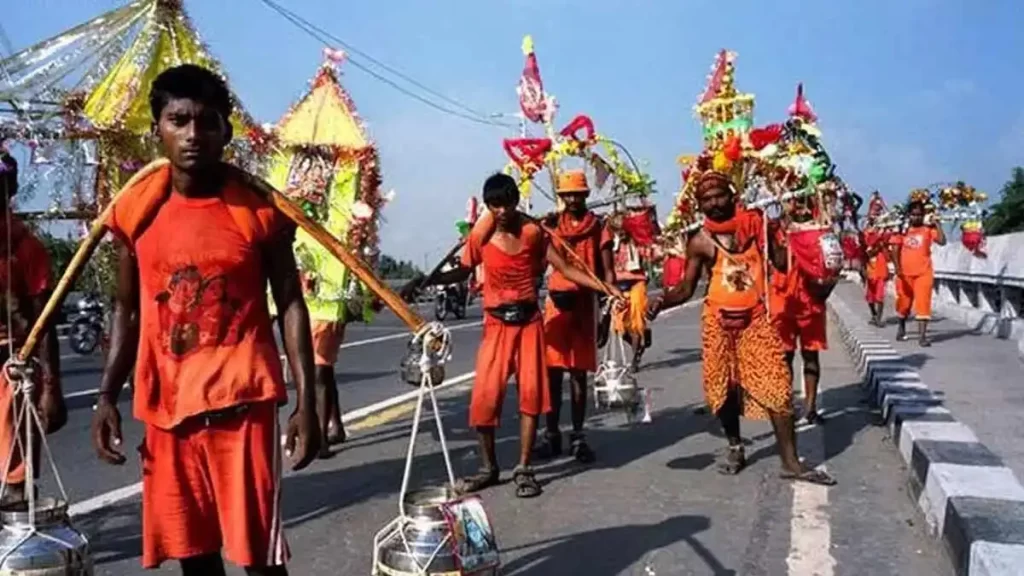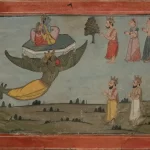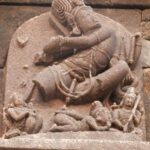Kanwariyas: Devotees Carrying Holy Water for Lord Shiva
Kanwariyas, As the month of Shravan begins and the earth is draped in a lush green carpet, thousands of Shiva devotees, known as Kanwariyas, embark on their sacred journey. These pilgrims are seen carrying water containers, tied to both ends of a rod, on their shoulders. They traverse long distances to fetch holy water from rivers, which they carry to offer to Lord Shiva.
In most places, the water is collected from the sacred river Ganga. However, in regions farther from the Ganga, devotees gather water from nearby rivers, continuing their tradition of devotion and faith.
Devotees often compare the Kanwar Yatra to the churning of the ocean (Samudra Manthan) during Satyuga. According to legend, when the deadly poison Halahal emerged from the ocean, no one dared to touch it. To save the world, Lord Shiva willingly consumed the poison. However, the toxic energy began to affect him after inhaling it.
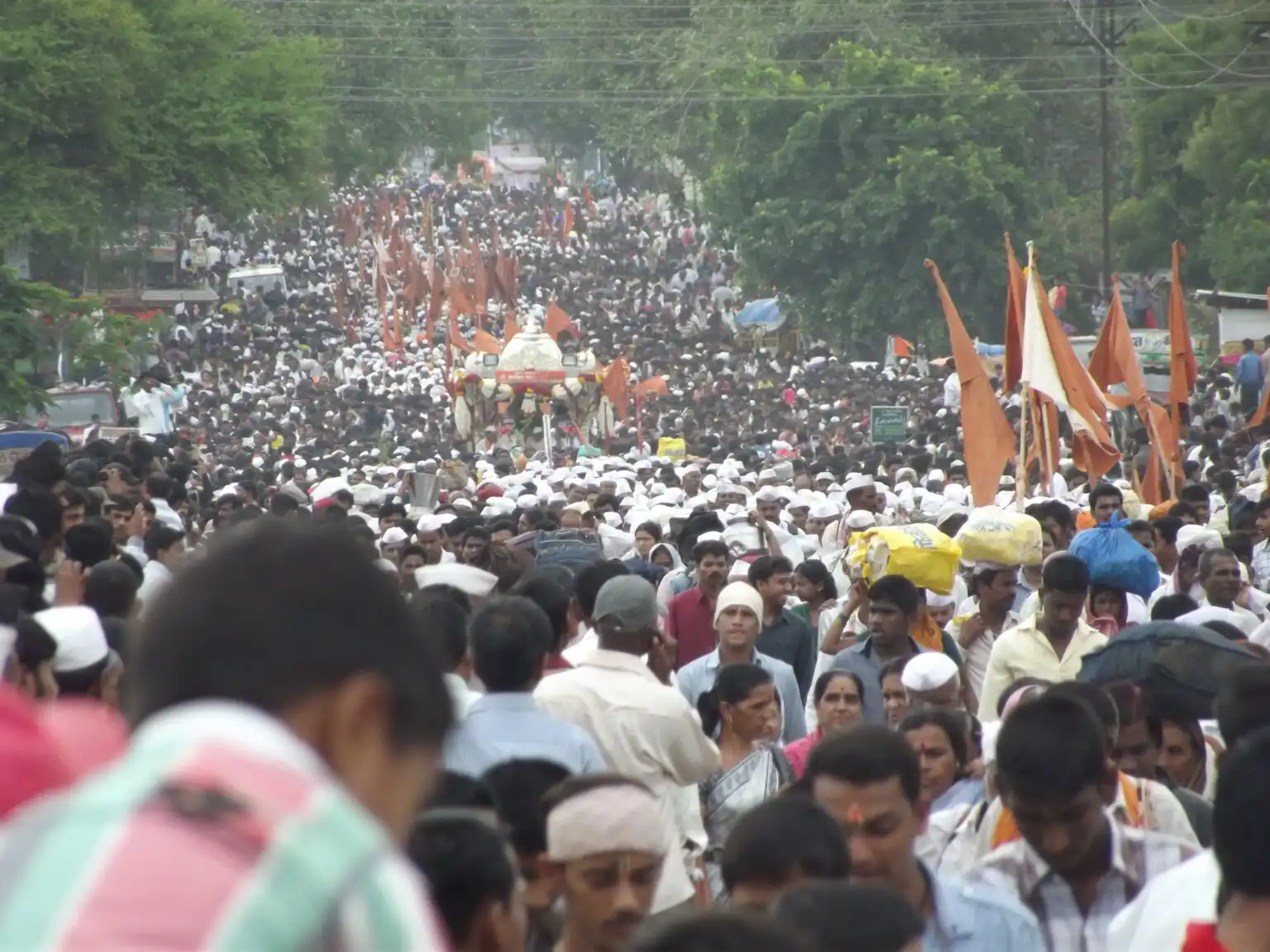
ALSO READ: Brahma: The Creator and Keeper of Universal Balance
Kanwariyas : The Sacred Journey of Devotion
In Treta Yuga, Ravana, a devoted worshiper of Shiva, used a kanwar to bring sacred water from the Ganga and poured it over Shiva’s shrine at Puramahadev. This act is believed to have freed Shiva from the negative energy of the poison. The tradition started by Ravana continues to be followed by devotees today through the Kanwar Yatra.
Beyond the Kanwariyas carrying water on their shoulders, there are numerous other examples of devotees trekking long distances to reach their deity, demonstrating their faith and dedication.
Every year during the month of Ashadha, thousands of devotees from across Maharashtra embark on a pilgrimage to Pandharpur, known as the Wari. This sacred journey holds deep roots in the medieval Bhakti tradition.
The Wari culminates on the day of Devshayani Ekadashi or Ashadhi Ekadashi, when all the processions converge in Pandharpur. Central to the pilgrimage is the carrying of the Paduka (traditional footwear) of revered saints by their followers in a decorated palanquin.
The Origins of the Kanwariyas: Legends and Traditions of Devotion
The two most prominent Waris begin from Dehu and Alandi, both located in the Pune region. As these places are closely associated with renowned saints of the Bhakti movement.
The origin of the Wari is explained through two prevailing theories.
According to one hypothesis, the Wari began during the time of Vitthalpant, the father of Saint Dnyaneshwar, who initiated the pilgrimage to Pandharpur between the months of Ashadha and Kartik. This tradition is believed to have continued for approximately 800 years.
Another account attributes the pilgrimage to Saints Dnyaneshwar and Tukaram, who traveled on foot for 15 days to Pandharpur, arriving at the Vithoba Temple on Shayani Ekadashi. In 1685, Narayan Maharaj, the youngest son of Tukaram, formalized the tradition of carrying the saints’ Paduka (sacred footwear) as part of the Wari.
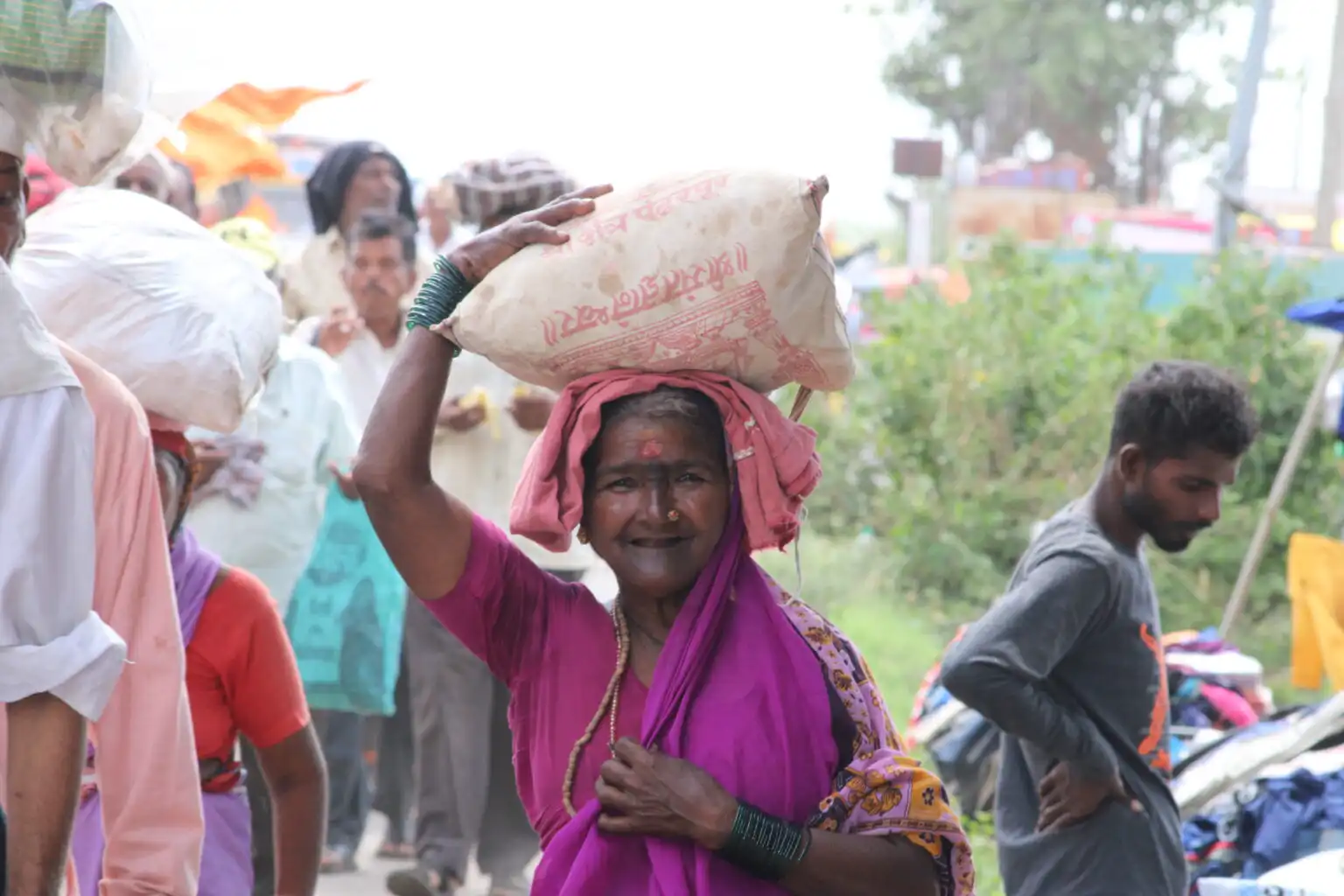
The Evolution of the Kanwariyas and the Splendor of the Jagannatha Rath Yatra
In the 1820s, Tukaram’s descendants, along with Haibatravbaba Arphalkar, a devotee of Dnyaneshwar and a courtier in the Scindia court of Gwalior, introduced changes to the traditional Wari pilgrimage. Haibatravbaba is credited with organizing the modern Wari.
These changes included structuring the followers, known as Varkaris, into groups called Dindis (a term referring to specific groups of Varkaris), incorporating horses into the procession, and carrying the Paduka in a palkhi (palanquin).
Today, nearly 10 lakh Varkaris undertake the 15-day journey on foot to reach Pandharpur, making it one of India’s largest religious gatherings. Recognizing its cultural and spiritual significance, the Maharashtra government has recently proposed the Wari for the UNESCO World Heritage Tag.
If we shift our focus from western India to eastern India, we encounter another spectacular pilgrimage celebration—the Jagannatha Rath Yatra in Puri, Odisha. This is one of the most renowned chariot festivals in the world.
Ratha Yatras: A Celebration of Faith Across Regions and Borders
A Rath Yatra, or chariot festival, refers to any public parade involving deities being carried on a chariot. Such festivals are held annually during specific celebrations in India, Nepal, and Sri Lanka, drawing massive gatherings of devotees and visitors alike.
Throughout India’s history, Ratha Yatra processions have played a significant role across various religious traditions. These include the Vishnu-related traditions (such as Jagannath, Rama, and Krishna), Shiva-related traditions, Nepali saints and goddesses, Jain Tirthankaras, and tribal folk religions in the eastern parts of the country.
Notable examples of Ratha Yatras include the Puri Ratha Yatra in Odisha, the Dhamrai Ratha Yatra in Bangladesh, and the Mahesh Ratha Yatra in West Bengal.
Additionally, Ratha Yatra celebrations extend beyond India’s borders. Hindu communities in countries like Singapore also organize these festivals, often associating them with deities such as Mariamman, Shiva, Krishna, and Jagannath, fostering a connection to their cultural and spiritual heritage.

The Magnificence of the Puri Ratha Yatra and Pilgrimages to Tirumala
The Ratha Yatra of Puri is regarded as the oldest and largest Hindu chariot festival. It is celebrated annually during the bright half of the lunar month of Ashadh (June–July). This grand festival is associated with Lord Jagannath, a deity representing Vishnu or Krishna.
During the celebration, three deities—Jagannath, his brother Balabhadra. And his sister Subhadra—are placed on three enormous wooden chariots and pulled by thousands of devotees along the Bada Danda. The grand avenue that leads to the Gundicha Temple. The deities remain at Gundicha Temple for a week before being brought back to the Jagannath Temple in a return journey known as the Bahuda Yatra.
The Ratha Yatra has been documented by European travelers since the 13th century, with the most notable and detailed accounts dating back to the 17th century.
If we look towards the southern part of India, we can see hundreds of devotees traveling from Tirupati to Tirumala to visit the Venkateshwara Swamy Temple, located on the Tirumala Hills.
Pilgrimages to Tirumala and Sabarimala
Devotees have two primary routes to reach the Vaishnavite shrine. One is the 2.5 km pathway that begins at Srivarimettu, while the other is the longer 7.8 km route starting from Alipiri. Both routes require traversing the hills, offering a spiritual journey before reaching the temple.
Before the construction of highways for vehicles, these pathways were the only means to access the sacred shrine. They have been in use for generations and remain an integral part of the pilgrimage experience to this day.
Pilgrims also embark on a 61-kilometer journey to reach the Ayyappa Swamy shrine at Sabarimala. The sacred path for this pilgrimage begins at Erumely, leading devotees through numerous rivers and hills before finally reaching Sabarimala.
Legend has it that Lord Ayyappa himself traveled this very route. And following the same path is believed to bring pilgrims closer to the deity. Before starting the pilgrimage, devotees must observe a 41-day Vratam (ritualistic vow) as part of their spiritual preparation.
While the traditional route spans 61 kilometers, some pilgrims opt for shorter alternatives. Such as the paths starting at Chalakayam (about 8 miles) or Vaniperiyar (around 13 kilometers).
Ancient Pilgrimages: Foot Journeys of Faith and Determination
In the past, walking was the only means of undertaking a pilgrimage. While those who could afford it had access to resources like horses or horse-drawn carts. Many others had to travel on foot from one location to the next.
A notable example from ancient texts is Shravana. A young child who is depicted escorting his blind parents on a pilgrimage in the Ramayana. Much like the Kanwariyas who carry water during the Kanwar Yatra, Shravana had fashioned a special Kanwar for this purpose.
Another significant journey is that of Adi Shankaracharya’s Digvijay Yatra. He traveled extensively, walking from the Himalayas to Kanyakumari and from Bengal to Gujarat. His purpose was not only to spread the philosophy of Vedic Hinduism but also to defeat his opponents in theological debates.
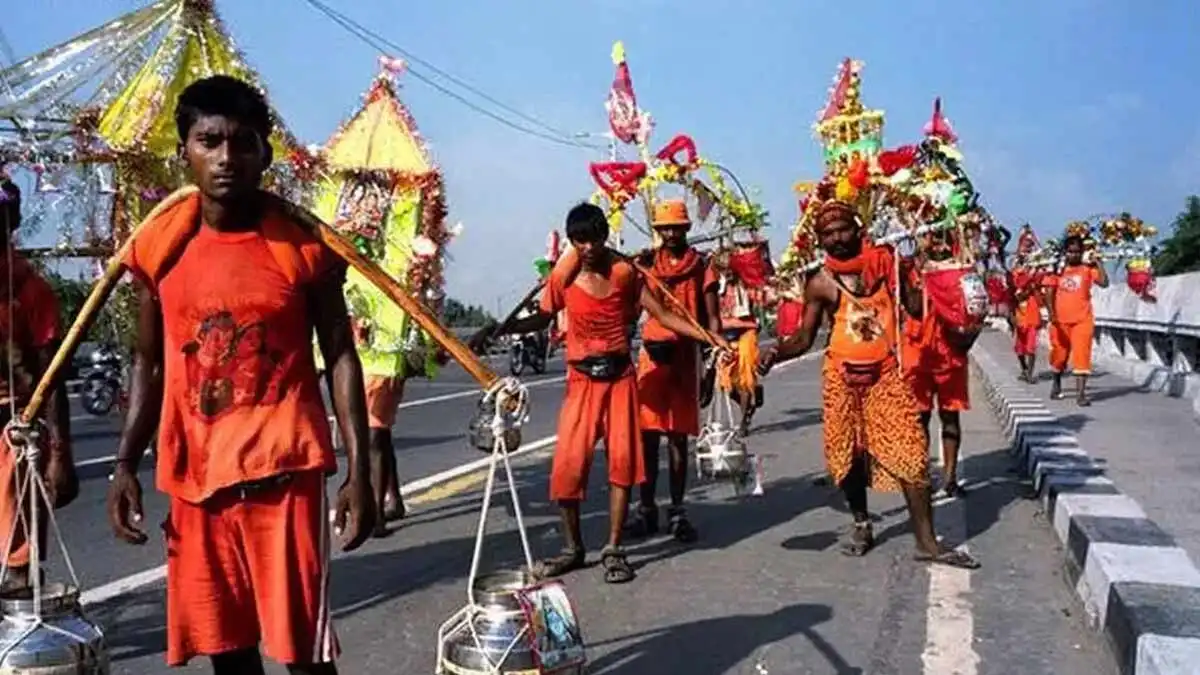
Long walks continue to be necessary for reaching sacred locations such as Kedarnath, Amarnath, Manasa Sarovar, Gangotri, and Yamunotri. These pilgrimages are challenging due to geographical constraints and unfavorable weather conditions.
The Spiritual Significance of Walking: A Journey of Devotion and Joy
However, one might wonder: Why would someone choose to walk when motorized roadways are available nearby? What motivates them to undertake such long journeys on foot?
For instance, the Warkaris walk with a Tulsi plant on their head, the Kanwariyas carry water jars on their shoulders. Jagannatha devotees pull the heavy wooden chariot with their hands. And Ayyappa devotees complete the 61-kilometer pilgrimage after over a month of intense Vratam. What drives individuals to endure such hardships on these spiritual journeys?
In 2022, I had the opportunity to participate in the Alandi to Pandharpur Wari. Despite the scorching heat, everyone walked with smiles on their faces. The journey was not easy; the pilgrims would become exhausted, suffer from leg pain. And often need to stop several times during their daily walk, which lasted four to five hours. However, despite these challenges, they remained happy and content. Their smiles were not just signs of physical endurance, but expressions of inner contentment and joy.
